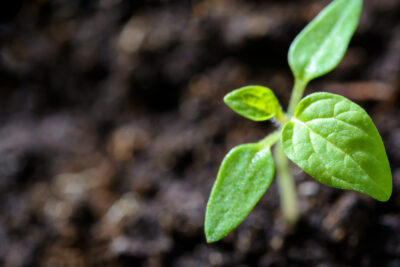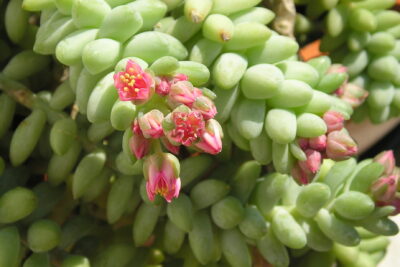
Fast-Growing Succulents: Seed-Grown Varieties Revealed

Succulents have become incredibly popular in recent years, with their unique shapes, vibrant colors, and low maintenance requirements making them a favorite among plant enthusiasts. While many succulents are known for their slow growth, there are actually several varieties that are fast-growing and can quickly fill out a pot or garden space. We will explore some of the top seed-grown succulents that are known for their rapid growth.
We will discuss the characteristics of fast-growing succulents and why they are a great choice for those looking to quickly establish a lush garden or indoor display. We will also provide a list of popular seed-grown succulents that are known for their speedy growth, including tips on how to care for and propagate them. Whether you're a succulent lover looking to expand your collection or a beginner gardener in search of low-maintenance plants, this article will provide valuable insights into the world of fast-growing succulents.
- Use a well-draining soil mix to promote healthy root growth
- Provide ample sunlight for optimal growth
- Water sparingly to prevent overhydration
- Protect seedlings from extreme temperatures
- Conclusion
- Water succulents sparingly to avoid overwatering and root rot
- Provide ample sunlight for at least 6 hours a day to encourage growth
- Use a balanced fertilizer to provide essential nutrients for faster growth
- Choose succulent varieties known for their fast-growing characteristics
- Propagate succulents through stem or leaf cuttings for quicker results
- Remove dead or wilted leaves to redirect energy towards new growth
- Prune succulents to promote branching and more compact growth
- Keep succulents in a warm and stable environment for optimal growth
- Protect succulents from extreme temperatures and frost to prevent damage
- Frequently Asked Questions
Use a well-draining soil mix to promote healthy root growth
When it comes to growing succulents from seeds, one of the most important factors to consider is the type of soil mix you use. Succulents have unique root systems that require excellent drainage to thrive. A well-draining soil mix ensures that excess water does not accumulate around the roots, preventing rot and other moisture-related issues.
For seed-grown succulents, it is essential to use a soil mix that is specifically formulated for succulent plants. You can either purchase a pre-made succulent soil mix from a garden center or make your own. A typical succulent soil mix consists of a combination of well-draining ingredients such as coarse sand, perlite, and a gritty, porous material like pumice or crushed granite.
It is crucial to avoid using regular potting soil or garden soil for succulents, as these retain moisture for longer periods, which can lead to root rot. Additionally, succulent seeds require a loose and airy soil mix to facilitate root development and prevent damping-off diseases.
When preparing your soil mix, ensure that it is well-mixed and free from any clumps or large particles. This will allow the tiny succulent seeds to establish contact with the soil, promoting germination and healthy root growth.
Provide ample sunlight for optimal growth
Succulents are known for their love of sunlight, and seed-grown varieties are no exception. Adequate sunlight is essential for the healthy growth and development of succulent seedlings.
 Exploring the Fascinating World of Tree-Like Succulent Plants
Exploring the Fascinating World of Tree-Like Succulent PlantsPlace your seed trays or pots in a location that receives bright, indirect sunlight for at least six hours a day. South-facing windowsills or well-lit areas in your garden are ideal spots for growing succulents from seeds.
If you are growing succulents indoors, you can supplement natural sunlight with artificial grow lights. LED grow lights are a popular choice as they provide the right spectrum of light for succulents without generating excessive heat.
Keep in mind that while succulents thrive in sunlight, they can also get sunburned if exposed to intense, direct sunlight for extended periods. If you notice signs of sunburn, such as discolored or bleached leaves, move the seedlings to a slightly shadier spot or provide some shade during the hottest part of the day.
Water sparingly to prevent overhydration
One of the biggest mistakes in growing succulents, especially from seeds, is overwatering. Succulents are adapted to arid climates and have evolved to store water in their leaves and stems. Therefore, they are highly susceptible to root rot and other issues caused by excessive moisture.
When watering seed-grown succulents, it is crucial to strike a balance between providing enough moisture for germination and early growth, while also allowing the soil to dry out between watering sessions.
A good practice is to wait until the soil is completely dry before watering again. Stick your finger about an inch into the soil – if it feels dry, it's time to water. Avoid using a spray bottle or misting the seedlings, as this can lead to shallow root development and increased susceptibility to diseases.
Additionally, be mindful of the temperature and humidity levels in your environment when determining the watering frequency. Succulents generally require less water during cooler months or in areas with higher humidity.
 Spiky Succulents: A Guide to Thorny and Spiky Types
Spiky Succulents: A Guide to Thorny and Spiky TypesProtect seedlings from extreme temperatures
Seed-grown succulents are more delicate and vulnerable to extreme temperatures compared to mature plants. It is essential to protect your succulent seedlings from sudden temperature fluctuations, especially during their early stages of growth.
Avoid placing your seed trays or pots in areas that are exposed to direct drafts or extreme heat sources, such as air conditioning vents or radiators. These can cause temperature spikes that can stress or damage the fragile seedlings.
During cold winter months, it's advisable to provide some insulation or move the seedlings to a warmer location. Consider using a frost cloth or placing the seed trays on a heating mat to maintain a more stable and suitable temperature for their growth.
Conclusion
Growing succulents from seeds is a rewarding experience that allows you to witness the entire lifecycle of these fascinating plants. By providing a well-draining soil mix, ample sunlight, careful watering, and protection from extreme temperatures, you can successfully grow a wide variety of succulent seedlings. Remember to be patient and enjoy the journey as your seed-grown succulents gradually transform into beautiful and resilient plants.
Water succulents sparingly to avoid overwatering and root rot
When it comes to succulents, one of the most important things to remember is to water them sparingly. These hardy plants have adapted to survive in arid environments by storing water in their leaves, stems, and roots. Overwatering can lead to root rot, a condition that can quickly kill your succulents.
So, how often should you water your succulents? The frequency will depend on various factors such as the climate, the size of the pot, and the type of succulent you have. As a general rule, it is best to wait until the soil is completely dry before watering again. To determine if it's time to water, stick your finger about an inch into the soil. If it feels dry, it's time to give your succulent a drink.
Remember that it's always better to underwater than to overwater. Succulents are more resilient to drought than they are to excess moisture. If you're unsure about the watering needs of your succulent, it's better to err on the side of caution and water less frequently.
 Vibrant Blooming Outdoor Succulents: Discover Stunning Plants
Vibrant Blooming Outdoor Succulents: Discover Stunning PlantsSigns of Overwatering
Overwatering can have detrimental effects on your succulents, so it's important to be able to recognize the signs. Here are a few indicators that your succulent may be suffering from too much moisture:
- Yellowing or wilting leaves: Overwatered succulents may develop yellow or transparent leaves that feel soft and mushy to the touch.
- Root rot: If you notice a foul smell coming from the soil or your succulent's roots appear black and mushy, it's a clear sign of root rot caused by overwatering.
- Leaf drop: Overwatered succulents may shed leaves as a defense mechanism to prevent further damage.
If you observe any of these signs, it's important to act quickly to save your succulent. Start by removing the affected leaves or roots and allow the plant to dry out completely. Adjust your watering schedule accordingly to prevent future overwatering.
Tips for Preventing Root Rot
Avoiding root rot in your succulents is crucial for their long-term health. Here are a few tips to help you prevent this common problem:
- Use well-draining soil: Succulents thrive in soil that allows excess water to drain away quickly. Choose a potting mix specifically designed for succulents or create your own by mixing regular potting soil with sand, perlite, or pumice.
- Opt for well-draining pots: Select pots with drainage holes to ensure that any excess water can escape. Avoid using pots without drainage or those with saucers that can trap water.
- Water from the bottom: Instead of watering from the top, try placing your succulent pot in a tray of water and allow the plant to soak up the moisture from the bottom. This method promotes healthy root growth and prevents water from sitting on the leaves.
- Do not mist succulents: While misting may be suitable for some houseplants, it's not recommended for succulents. The tiny droplets can accumulate on the leaves and create a humid environment, which encourages the growth of mold and fungi.
By following these guidelines and being mindful of your succulent's watering needs, you can enjoy a thriving collection of fast-growing succulents without the risk of root rot.
Provide ample sunlight for at least 6 hours a day to encourage growth
When it comes to fast-growing succulents, providing ample sunlight is crucial for their growth and development. These plants thrive in bright light conditions, so it's important to place them in an area that receives at least 6 hours of direct sunlight each day.
Exposure to sunlight triggers photosynthesis in succulents, allowing them to produce energy and grow at a rapid pace. Without sufficient sunlight, these seed-grown varieties may become weak and leggy, compromising their overall health and appearance.
To ensure your fast-growing succulents receive enough sunlight, consider placing them near a sunny window or outdoors in a spot with direct sunlight. If you're growing them indoors, you may need to rotate the pots periodically to ensure all sides of the plants receive equal exposure to sunlight.
 Discover the Perfect Buddha Temple Succulent for Your Home
Discover the Perfect Buddha Temple Succulent for Your HomeIt's important to note that while succulents love sunlight, intense and prolonged exposure to harsh afternoon sun can be harmful. In such cases, it's advisable to provide some shade during the hottest part of the day or use a sheer curtain to filter the sunlight.
Additionally, if you notice your seed-grown succulents stretching towards the light source, it's a sign that they are not receiving enough sunlight. In this case, you may need to adjust their placement to a brighter location or consider using artificial grow lights to supplement their light requirements.
Water your fast-growing succulents sparingly
In addition to sunlight, proper watering is crucial for the growth and well-being of fast-growing succulents. These plants have evolved to thrive in arid and dry conditions, making them highly efficient at storing water in their leaves and stems.
When watering your seed-grown succulents, it's important to follow a "less is more" approach. Overwatering can lead to root rot and other moisture-related issues, ultimately stunting the growth of your plants.
As a general rule, allow the soil to dry out completely between waterings. This ensures that the roots have a chance to breathe and prevents the risk of overhydration. Succulents are drought-tolerant plants, and they are generally more forgiving when it comes to underwatering rather than overwatering.
When watering, make sure to soak the soil thoroughly until water drains out from the bottom of the pot. Then, allow the excess water to drain completely before placing the pot back in its original location. Avoid leaving your succulents sitting in standing water, as this can lead to root rot.
Remember, the frequency of watering will depend on various factors such as the climate, pot size, and the type of succulent. It's always best to observe your plants and adjust your watering schedule accordingly.
 Best Pink Flowering Ground Cover Succulents for Your Garden
Best Pink Flowering Ground Cover Succulents for Your Garden- Check the moisture level of the soil before watering
- Water deeply but infrequently
- Avoid overwatering to prevent root rot
- Allow the excess water to drain completely
By following these watering guidelines, you'll ensure that your fast-growing succulents have the right amount of moisture to support their growth without risking their health.
Use a balanced fertilizer to provide essential nutrients for faster growth
When it comes to fast-growing succulents, providing them with the right nutrients is crucial. One way to ensure optimal growth is by using a balanced fertilizer. Succulents require a combination of macronutrients and micronutrients to thrive, and a balanced fertilizer can provide them with these essential elements.
A balanced fertilizer typically contains equal proportions of nitrogen (N), phosphorus (P), and potassium (K) – the three primary macronutrients required for plant growth. Nitrogen promotes healthy leaf and stem development, phosphorus aids in root growth and flower production, while potassium helps with overall plant health and disease resistance.
However, it's essential to choose a fertilizer specifically formulated for succulents. These fertilizers often have lower nitrogen concentrations to prevent excessive leaf growth, which can make succulents leggy and less compact. Look for a fertilizer with an NPK ratio of around 2-7-7 or 3-6-6, as these ratios are suitable for most succulent varieties.
When applying the fertilizer, follow the instructions provided on the packaging. Usually, it's recommended to dilute the fertilizer with water to avoid burning the plant's roots. Apply the diluted fertilizer to the soil around the succulent, making sure to distribute it evenly.
Remember, though, that succulents are adapted to survive in nutrient-poor environments. While fertilizing can accelerate their growth, it's crucial not to overdo it. Applying fertilizer once every two to four weeks during the growing season is generally sufficient. During the dormant season or in winter, it's best to avoid fertilization altogether.
 10 Unique Indoor Succulents That Resemble Hair for a Whimsical Touch
10 Unique Indoor Succulents That Resemble Hair for a Whimsical TouchIn addition to using a balanced fertilizer, it's essential to provide other care requirements for your fast-growing succulents. Ensure they receive adequate sunlight, as succulents are sun-loving plants. Water them sparingly, allowing the soil to dry out between waterings to prevent root rot. Also, choose well-draining soil that replicates the succulent's natural habitat.
By providing your fast-growing succulents with a balanced fertilizer and meeting their other care needs, you'll be rewarded with vibrant and healthy plants that thrive in your collection.
Choose succulent varieties known for their fast-growing characteristics
If you're a succulent enthusiast looking to add some rapidly-growing varieties to your collection, you're in luck! There are several seed-grown succulents that are known for their fast-growing nature.
1. Echeveria 'Lola'
Echeveria 'Lola' is a popular succulent variety that grows quickly and forms beautiful rosettes. Its vibrant pink and purple colors make it a stunning addition to any succulent garden or indoor arrangement. With proper care, 'Lola' can grow multiple offsets, allowing you to propagate and expand your collection in no time.
2. Sedum 'Angelina'
Sedum 'Angelina' is a low-growing succulent that spreads quickly with its trailing stems. It features vibrant yellow-green foliage, which turns orange and red during the cooler months. This fast-growing succulent is perfect for ground cover or hanging baskets, adding a pop of color to your outdoor spaces.
3. Crassula ovata (Jade Plant)
The Jade Plant, also known as Crassula ovata, is a popular succulent that grows rapidly, especially in the right conditions. With its thick, fleshy leaves and tree-like appearance, the Jade Plant adds a touch of elegance to any space. It is easy to propagate from stem or leaf cuttings, making it a great choice for beginners.
 Top 10 Tall Succulent Plants: Perfect for Indoor or Outdoor Use
Top 10 Tall Succulent Plants: Perfect for Indoor or Outdoor Use4. Kalanchoe 'Mother of Thousands'
Kalanchoe 'Mother of Thousands' is a unique succulent that reproduces rapidly through tiny plantlets that grow along the edges of its leaves. These plantlets easily drop off and root themselves, creating new plants effortlessly. This fast-growing variety is a fascinating addition to your succulent collection.
Remember, while these succulents are known for their fast growth, they still require proper care and attention to thrive. Ensure they receive adequate sunlight, well-draining soil, and regular watering to support their growth.
By choosing these fast-growing succulent varieties, you can enjoy watching your collection expand and flourish in no time!
Propagate succulents through stem or leaf cuttings for quicker results
Succulents are a popular choice for both indoor and outdoor gardening due to their unique and eye-catching appearance. While many succulents can be propagated through stem or leaf cuttings, there are some varieties that can be grown from seeds, resulting in faster growth and more efficient propagation.
Benefits of Seed-Grown Succulents
Growing succulents from seeds offers several advantages over other propagation methods. Firstly, it allows you to have a wider variety of succulents in your collection, as many unique and rare varieties are only available as seeds. Secondly, seed-grown succulents tend to have stronger and healthier root systems, which contributes to their overall growth and longevity.
Recommended Seed-Grown Succulents
If you're eager to try your hand at growing succulents from seeds, here are some fast-growing varieties that are worth considering:
- Sedum kamtschaticum: This low-growing succulent is known for its vibrant yellow flowers and its ability to tolerate a wide range of growing conditions, making it an excellent choice for beginners.
- Graptopetalum paraguayense: Also known as the "Ghost Plant," this succulent has beautiful rosettes of pale blue-green leaves. It is a fast grower and can be easily propagated from both seeds and stem cuttings.
- Echeveria elegans: With its powdery blue-green leaves and rosette shape, this succulent adds a touch of elegance to any garden. It can be grown from seeds, but keep in mind that it may take longer to reach maturity compared to other varieties.
Tips for Growing Seed-Grown Succulents
While growing succulents from seeds can be a rewarding experience, it requires some patience and attention to detail. Here are a few tips to help you succeed:
 Exploring Fred Ives: A Specialist in Succulent Cultivation
Exploring Fred Ives: A Specialist in Succulent Cultivation- Choose high-quality seeds: Look for reputable seed suppliers to ensure you're getting viable seeds that will germinate successfully.
- Provide proper growing conditions: Succulents thrive in well-draining soil and bright, indirect sunlight. Keep the soil slightly moist during germination, but avoid overwatering.
- Be patient: It may take several weeks or even months for your succulent seeds to germinate and grow into mature plants. Don't get discouraged and continue providing the necessary care.
- Transplant with care: Once your seedlings have grown a few sets of leaves, carefully transplant them into individual pots using a well-draining succulent mix.
By exploring the world of seed-grown succulents, you can discover a whole new range of unique and fascinating varieties. With a little patience and the right growing conditions, you'll be rewarded with a stunning collection of fast-growing succulents to enjoy for years to come.
Remove dead or wilted leaves to redirect energy towards new growth
When it comes to cultivating fast-growing succulents, one of the key steps you shouldn't overlook is removing dead or wilted leaves. By doing so, you redirect the plant's energy towards new growth, ensuring that it thrives and flourishes.
Dead or wilted leaves can hinder the growth of your succulents. They not only take up valuable nutrients but also create a breeding ground for pests and diseases. By removing these leaves, you create space for healthy leaves to emerge and allow the plant to allocate its resources more efficiently.
Here are a few tips on how to properly remove dead or wilted leaves from your succulents:
- Inspect the plant: Take a close look at your succulent and identify any leaves that are dead or wilted. These leaves may appear discolored, shriveled, or mushy.
- Gently tug: Use your fingers or a pair of sterile pruners to gently tug on the dead or wilted leaves. If they come off easily, they are ready to be removed.
- Trim if needed: In some cases, the dead or wilted leaves may be attached to healthy parts of the plant. If this is the case, use sterile pruners to carefully trim the leaf close to the base.
- Dispose properly: Once you have removed the dead or wilted leaves, make sure to dispose of them properly. Do not leave them near your succulent or in the same pot, as this can attract pests or spread diseases.
By regularly removing dead or wilted leaves from your fast-growing succulents, you encourage healthy growth and help maintain the overall well-being of your plants. Remember to always handle your succulents with care and maintain good hygiene to prevent the spread of any potential infections.
Prune succulents to promote branching and more compact growth
When it comes to growing succulents, one of the most effective ways to promote branching and more compact growth is through pruning. Pruning is the process of removing parts of the succulent plant, such as stems or leaves, to encourage new growth and shape the plant to your desired form.
 Top Succulents with White Hair: A Guide to the Best Varieties
Top Succulents with White Hair: A Guide to the Best VarietiesHere are some tips and techniques for pruning succulents:
1. Use clean and sharp tools
Before you start pruning your succulents, make sure to clean your tools with rubbing alcohol to prevent the spread of any diseases or pests. Additionally, use sharp and sterile pruning shears or scissors to make clean cuts, as this will minimize damage to the plant.
2. Choose the right time
It is best to prune succulents during their active growing season, which is typically in spring or early summer. This allows the plant to recover and heal more quickly. Avoid pruning during the dormant period or in winter, as this can hinder the plant's growth and potentially cause damage.
3. Identify the areas to prune
Before you start cutting, take a close look at your succulent and identify the areas that need pruning. Look for leggy or elongated stems, dead or damaged leaves, or any parts that are obstructing the plant's overall shape or growth.
4. Cut above a node or leaf joint
When making cuts, it is essential to cut above a node or leaf joint. Nodes are the areas on the stem where leaves or branches emerge, and cutting above them encourages new growth. This technique helps the succulent to branch out and become more compact.
5. Remove dead or yellowing leaves
Dead or yellowing leaves not only detract from the plant's appearance but can also attract pests or diseases. Carefully remove these leaves by gently pulling them away from the stem or using pruning shears. Be cautious not to damage any healthy parts of the plant while doing so.
Remember, pruning succulents is a gradual process, and it's always better to start with minimal pruning and gradually increase as needed. By following these tips, you can help your succulents thrive and achieve a more compact and aesthetically pleasing growth pattern.
 Top 10 Succulents That Flourish in Partial Sunlight: A Guide
Top 10 Succulents That Flourish in Partial Sunlight: A GuideKeep succulents in a warm and stable environment for optimal growth
When it comes to growing fast-growing succulents from seeds, providing the right environment is crucial. These desert plants thrive in warm, dry climates, so it's important to recreate those conditions as closely as possible. Here are some key factors to keep in mind:
Temperature
Succulents prefer temperatures between 70-90°F (21-32°C) during the day and slightly cooler temperatures at night. Keep them away from drafts or extreme temperature fluctuations, as this can stress the plants and hinder their growth.
Light
Succulents need plenty of bright, indirect sunlight to grow well. Place them near a sunny window or provide them with artificial grow lights if natural light is insufficient. Avoid exposing them to direct sunlight for extended periods, as it can scorch their leaves.
Soil
Choose a well-draining soil mix specifically formulated for succulents. A standard potting mix may retain too much moisture, leading to root rot. Consider adding perlite or coarse sand to improve drainage and ensure healthy root development.
Watering
Succulents are adapted to survive in arid conditions, so they don't need frequent watering. Allow the soil to dry out completely between waterings, and make sure to water deeply to encourage the roots to grow downward. Overwatering can be detrimental to succulents, leading to root rot and other issues.
Fertilizer
While succulents are relatively low-maintenance, they do benefit from occasional fertilization during their growing season. Use a balanced, water-soluble fertilizer diluted to half or quarter strength, and apply it according to the package instructions. Be careful not to over-fertilize, as this can cause the plants to become leggy or susceptible to pests.
By providing the right environment and following these care tips, you can ensure that your seed-grown succulents will grow quickly and thrive. With their unique shapes and vibrant colors, these fast-growing varieties will add a touch of beauty to any indoor or outdoor space.
Protect succulents from extreme temperatures and frost to prevent damage
Succulents are known for their ability to thrive in arid conditions and withstand harsh environments. However, they still need some protection from extreme temperatures and frost to prevent damage. Here are some tips to keep your succulents safe:
1. Provide shelter in winter
During the winter months, it's important to provide shelter for your succulents to shield them from freezing temperatures. You can move them indoors or place them in a greenhouse or cold frame. If you choose to keep them outdoors, cover them with a frost cloth or burlap to provide some insulation.
2. Avoid overwatering
Overwatering in cold weather can lead to root rot and other issues. Succulents are adapted to survive with minimal water, so it's crucial to adjust your watering schedule accordingly. Make sure the soil is dry before watering and reduce the frequency of watering during winter.
3. Choose frost-resistant varieties
Not all succulents are equally tolerant of frost. Some varieties, such as Sedum spectabile and Agave parryi, are more resistant to cold temperatures. When selecting succulents for your garden, consider choosing frost-resistant varieties that can withstand chilly weather without suffering damage.
4. Mulch for insulation
Applying a layer of mulch around the base of your succulents can provide insulation and protect the roots from freezing. Use organic mulch, such as wood chips or straw, and ensure that the mulch is not touching the stems or leaves of the plants to prevent rot.
5. Monitor temperature fluctuations
Succulents are sensitive to rapid temperature changes. Keep an eye on the weather forecast and be prepared to take action if temperatures are expected to drop drastically. Consider using frost covers or moving your succulents to a more protected area if necessary.
By following these tips, you can ensure that your succulents stay healthy and beautiful even during extreme temperatures and frost. Remember to always observe and respond to the specific needs of your succulents to provide them with the best care possible.
Frequently Asked Questions
1. Can all succulents be grown from seeds?
No, not all succulents can be grown from seeds. Some succulents, like Echeveria, are commonly propagated from leaf or stem cuttings.
2. What are some fast-growing succulents that can be grown from seeds?
Some fast-growing succulents that can be grown from seeds include Sedum, Sempervivum, and Kalanchoe.
3. How long does it take for seed-grown succulents to reach maturity?
The time it takes for seed-grown succulents to reach maturity can vary depending on the species and growing conditions. It can range from several months to a few years.
4. What are the advantages of growing succulents from seeds?
Growing succulents from seeds allows for a wider variety of species and cultivars to be grown. It can also be a rewarding and educational experience for succulent enthusiasts.
If you want to read more articles similar to Fast-Growing Succulents: Seed-Grown Varieties Revealed, you can visit the Varieties and Colors category.






You Must Read